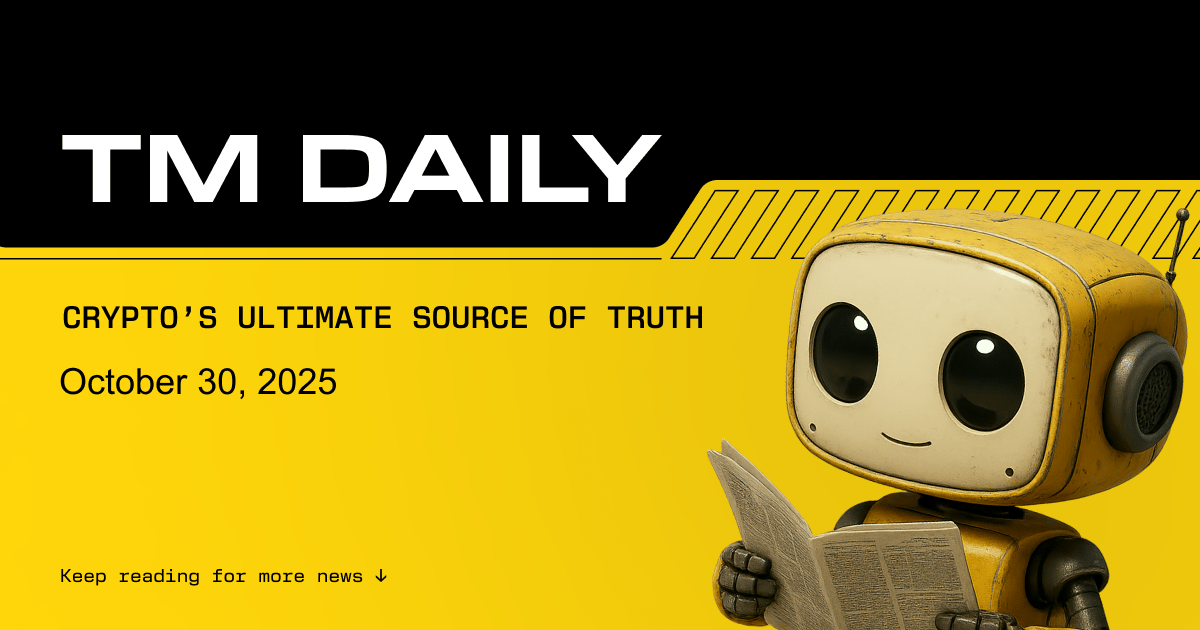Today's edition of Token Metrics Research | Daily Newsletter is brought to you by CoW Swap.
Best Price. Every Trade.
Built for active crypto traders. CoW Swap always searches across every major DEX and delivers the best execution price on every swap you make. Smarter routes. Better trades. No wasted value. Find your best price today. So why trade on any one DEX when you can use them all?
Now let's get back to the top stories of the day.
Market Summary — October 30, 2025
Risk reset after the Fed. The Federal Reserve cut rates by 25 basis points and signaled an end to quantitative tightening, yet crypto traded heavy into the close. Bitcoin slipped to roughly $109,000, a fast reversal from last week’s test near $116,000. Ether hovered around $3,900. The message from Chair Powell emphasized caution on the outlook, and markets quickly recalibrated the path of policy into year end.
Leverage unwound. Derivatives saw long side stress with an estimated $590 million in crypto liquidations over the last 24 hours. Spot was orderly, but futures basis compressed and funding swung lower as momentum accounts reduced risk. The immediate technical battleground for BTC is the $110,000 support zone; below that, traders will look to recent pivot lows.
Flows are the tell. After the shakeout, watch for renewed ETF inflows and stablecoin issuance as signals that dip buyers are returning. If flows stay muted, macro sensitive assets may continue to drift until the next catalyst.
1. Fed cuts 25 bps; Bitcoin drops to ~$109K as markets digest end of QT

What happened: The Fed delivered a 25 basis point rate cut and confirmed it will stop shrinking its balance sheet. Despite the historically supportive combination of lower policy rates and a pause in balance sheet runoff, Bitcoin fell quickly to about $109.2K. The move reflected a repricing of growth and inflation risks and a sober tone from Chair Powell that kept policy uncertainty elevated.
Why it matters: In this cycle, the policy path and liquidity backdrop continue to be the dominant macro drivers for digital assets. With positioning stretched into the decision, the post FOMC downdraft hit leveraged longs, pushing BTC back toward a key area that traders are watching for confirmation of support. Liquidations across majors underscored how quickly momentum can flip when macro headlines disappoint.
Market context: Heading into the meeting, BTC had already faded a push toward $116K while ETH consolidated near $3.9K. After the announcement, futures funding turned more neutral and options markets priced a modest uptick in near term realized volatility. Several desks flagged ETF net flows as the next key indicator. If inflows return, the dip could prove short lived; if not, markets may probe recent pivot lows before finding a durable base.
- Levels to watch: Support at $110K; resistance in the $112.5K–$116K range.
- Positioning: Reduced leverage and tighter risk budgets remain prudent until flows stabilize.
- Volatility: Short dated skew suggests demand for downside hedges; IV likely to stay bid into data and month end.
Token Metrics take: Treat $110K as the near term line in the sand. A swift recovery with positive ETF prints would signal trend resilience. Absent that, we expect continued chop and a search for lower support, where long term buyers may scale in gradually.
2. Mastercard in late stage talks to acquire Zero Hash for $1.5–$2B

What happened: Mastercard is reportedly finalizing a deal to acquire Zero Hash, a Chicago based crypto and stablecoin infrastructure provider, for roughly $1.5–$2 billion. Zero Hash powers fiat to crypto conversions, custody, tokenization, and settlement APIs for fintechs and financial institutions. While neither party has publicly confirmed terms, talks are said to be in the last mile.
Why it matters: This would be a landmark bet on on chain settlement across major payment rails. By bringing Zero Hash’s stack in house, Mastercard could standardize 24/7 stablecoin flows for corporate treasuries, cross border payouts, and tokenized fund rails. That directly addresses rising demand from enterprises seeking faster settlement, lower costs, and always on liquidity versus legacy systems.
Strategic implications:
- Network effects: Integrating custody and tokenization at the network layer reduces onboarding friction for banks and fintechs.
- Stablecoin utility: Embedding stablecoin rails into merchant acquiring and treasury services would expand real world use cases.
- Competitive pressure: Exerts pressure on rivals to accelerate their own crypto settlement capabilities.
What to watch: Integration timelines, regulatory clearances, and early pilot programs with marquee corporate clients. Any announcements around tokenized fund distribution or cross border corridors will be a strong signal of near term adoption.
Token Metrics take: If completed, the deal would be one of the clearest signs this year that stablecoin settlement is graduating from pilots to production. We see this as a constructive catalyst for infrastructure and liquidity providers that serve enterprise grade on chain flows.
3. Consensys lines up JPMorgan and Goldman Sachs to lead planned IPO

What happened: The parent of MetaMask, Consensys, has reportedly tapped JPMorgan and Goldman Sachs to lead a U.S. public listing targeted for 2026. The company has been signaling capital markets readiness after resolving a key SEC dispute relating to MetaMask staking earlier this year, while continuing to scale infrastructure products such as Infura and the Linea network.
Why it matters: A Consensys IPO would be one of the largest crypto native infrastructure listings yet and a sentiment barometer for public equity appetite following the 2025 ETF wave. It could establish fresh valuation benchmarks for Web3 infrastructure, developer tooling, and wallet businesses heading into 2026.
Key investor questions:
- Revenue mix and durability: How much is tied to developer infrastructure versus consumer wallet activity?
- Margins and scale: How will Linea and Infura economics evolve as throughput and data demands rise?
- Regulatory posture: With prior disputes addressed, what ongoing compliance investments shape future product roadmaps?
Token Metrics take: Public market access for crypto infrastructure companies is reopening. If executed, Consensys’ listing would help define comps for wallets and node infrastructure, improving price discovery for late stage private investors and potentially catalyzing more venture to public exits in 2026.
4. Germany’s AfD party proposes adding Bitcoin to national reserves

What happened: Germany’s Alternative for Germany (AfD), a major opposition party, reportedly introduced a motion to establish a national Bitcoin reserve. The proposal frames Bitcoin as state free money and a potential inflation hedge, arguing for diversification alongside gold and foreign currency holdings. It follows a similar push in France for a national Bitcoin strategic reserve.
Why it matters: The idea of sovereign Bitcoin allocations is no longer fringe in Europe. This is a notable shift considering Germany sold nearly 50,000 BTC seized in 2024. Even if the proposal faces political hurdles, it puts Bitcoin on the policy agenda as a reserve consideration and may influence debates across the region.
What to watch:
- Legislative traction: Committee debates, coalition responses, and any central bank commentary.
- Reserve strategy: Whether proposals focus on direct BTC holdings, structured products, or a phased accumulation plan.
- International signaling: Ripple effects on other EU members evaluating digital asset reserve frameworks.
Token Metrics take: Sovereign exploration of Bitcoin as a reserve asset is a powerful narrative for long term adoption. Policy cadence will be slow, but each proposal expands the Overton window for institutional and public sector participation.
Key Takeaways
- The Fed cut 25 bps and ended QT, but crypto traded risk off with BTC testing the $110K support zone.
- Roughly $590 million in liquidations highlight how quickly leverage can flip when macro headlines disappoint.
- Mastercard’s pursuit of Zero Hash underscores the acceleration of stablecoin settlement across mainstream payment rails.
- Consensys’ reported IPO plans would set important comps for Web3 infrastructure and wallets in public markets.
- Germany’s AfD proposal adds momentum to sovereign conversations around Bitcoin reserves in Europe.
Outlook
Into the next few sessions, flows are in focus. A quick rebound in ETF inflows and a hold of the $110K area would support the case for a durable BTC range and renewed risk appetite. If flows remain tepid, expect a prolonged chop with downside tests toward recent lows as the market seeks a cleaner positioning reset. For builders and investors alike, real world adoption stories—stablecoin settlement at scale, tokenized funds, and enterprise grade infrastructure—continue to compound beneath the surface, setting the stage for the next leg once macro stabilizes.
This content is for informational purposes only and should not be considered investment advice. Do your own research and manage risk accordingly.
This edition of the newsletter is co-presented by Proton Mail.
Free email without sacrificing your privacy
Gmail tracks you. Proton doesn’t. Get private email that puts your data — and your privacy — first.
Now, let's continue with the deep dive/hidden gems, TM Daily.
Today’s newsletter is also powered by Money.com.
Debt sucks. Getting out doesn’t have to.
Americans’ credit card debt has surpassed $1.2 trillion, and high interest rates are making it harder to catch up (yes, even if you’re making your payments). If you’re in the same boat as millions of Americans, debt relief companies could help by negotiating directly with creditors to reduce what you owe by up to 60%. Check out Money’s list of the best debt relief programs, answer a few short questions, and get your free rate today.
That's all for today. Let's talk tomorrow.





